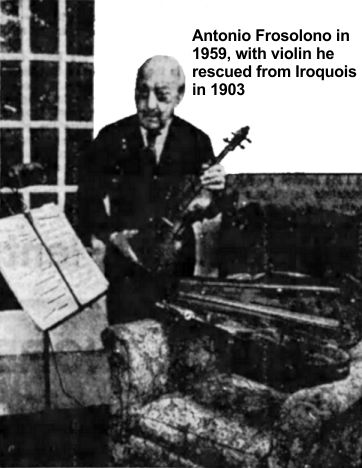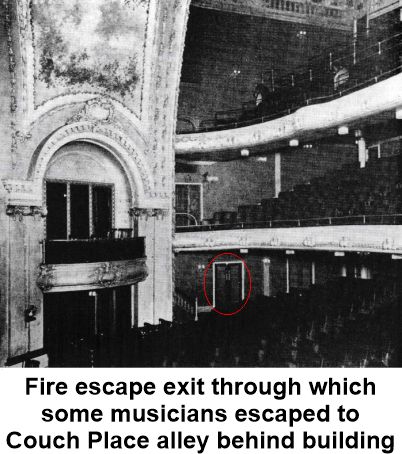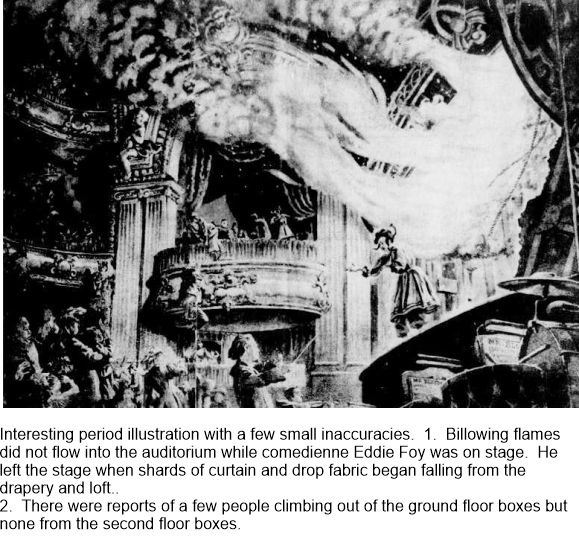|
Iroquois Theater orchestra probably included twenty-six muscians
I've found no lists of members of the Iroquois
Theater orchestra and varying period references up to forty members. An interview with
director Dilley reported twenty-six; a newspaper
report in the Richmond, Indiana newspaper where
lived the parents of cello player Eddo Kline,
described their relief at learning their son was
among the survivors in the thirty-three member
orchestra. Philip Carli,▼1 (to whom I am much
indebted for providing information about theater
orchestras of the period), feels twenty-six was the number that would have been in keeping with theater orchestra compositions of the time.
Those identified thus far are listed at right in the
green panel. (I'll update the list as more information
is found. This story will be "in progress" for some
time.) So far I've identified the names of nine men and one woman.
Play on
Comedian Eddie Foy and
both orchestra directors at the Iroquois Theater
believed that music would calm the audience. Since
multiple audience survivors described being unable
to hear Foy from the stage, urging calm, it is
likely they were also unable to hear the orchestra
playing. Nearby screams functioned as a sound
barrier. Nonetheless, a half dozen musicians kept
playing until soon after the fireball shot into the
auditorium.
According to testimony at the coroner's trial, Eddie
Foy urged the orchestra to play an overture, and
director Herbert Dillea led the group in playing
the Sleeping Beauty and the Beast Overture. Sleeping Beauty was
another Drury Lane Theater production that Klaw and
Erlanger had imported and for which
Frederick Solomon had composed much of the music, playing in August 1902
at the Illinois Theater in Chicago, also managed by
Will J. Davis, probably by some of the same musicians that were
performing Mr. Bluebeard at the Iroquois. Second director and violinist Antonio Frosolono also described urging the musicians to keep playing.
On January 7, 1904 Frosolono testified before the
grand jury about his experience at the Iroquois
Theater. He described the fire curtain lowering,
sticking, and bulging just before the fireball
hurled into the auditorium. He also told of a fire
hose beneath the stage in a restroom. (Later witnesses would
testify that water had not been plumbed to the stage
fire hoses.)
Frosolono and a half dozen other musicians,
including Dillea and Brown, continued performing
until the bass and cello caught fire. Brown
testified that they had no more evacuated than the
woodwork in the pit caught fire. Eddie Foy was
quoted as saying that by the time the last orchestra
member, Herbert Dillea, left the orchestra pit, the
ground floor of the auditorium was half emptied.
Foy and Brown's remarks reveal that though there
were few fatalities among audience members seated on
the ground floor, the risk to musicians was greater
than I appreciated initially. The orchestra pit was in
flames as the last of the audience on the ground
floor moved into the lobby, which means musicians
who stayed to perform had to flee quickly.

Under ordinary circumstances musicians were expected to leave the orchestra pit via an 18-inch wide exit beneath and in front of
the stage that led to a stairwell down to an east-west basement hallway lined by dressing rooms, costume
rooms, and, at the south end, washrooms and smoking
rooms used by theater patrons. Musician Arthur C.
Brown described the opening as narrow and awkwardly
configured, requiring the musicians to "twist and
wiggle" to pass through. At the end of the hallway was another stairwell that led up to a exit out onto Dearborn St.
(door #5). When that passage became filled with smoke some orchestra members such as
Anthony Frosolono, escaped through a bathroom window.
Others made their way to a spiral stairwell on the
north side of the theater that ran from the basement all the way up to box seats on the second floor. At the first
floor was a set of stairs that branched out to the auditorium floor (see accompanying photo)
and a fire escape exit on Couch Place alley (door #2).
The orchestra pit exit was compromised due to another Iroquois
planning error. The floor depth was originally seventy-eight inches, said to be in keeping with European standards at the time. At the dress rehearsal, it was decided that the music could not be heard sufficiently so a false wood floor was installed atop the concrete floor, raising the floor height. Still unsatisfactory, a second wood floor addition was installed. The measurements cited in
newspaper stories resulting from an interview with Arthur
Brown are conflicting, and the actual floor height in the
orchestra pit is not known but there's little wonder
some musicians were forced to leave their
instruments behind.
By the time the fire was out and bodies removed,
the basement and orchestra pit was
filled with water from the fire hoses, requiring
pumping the day after the fire.
The often published picture of a fire pumper in
Couch Place alley was likely taken the day after the
fire when the basement was being pumped.

|

|
|
Iroquois Theater orchestra members:
-
Herbert Dillea — 1st baton
-
Charles Bibel — trombone
-
Arthur Curry Brown — double bass
-
Carlos Arriolas — flute
-
Ernest M. Libonati — violin
-
Florence Louise Horne (1880–1956)▼2 — cornet
Studied with composer and cornet virtuoso,
Robert
Brown Hall, and performed as soloist with various groups,
including the Fadettes of Boston, Cecilia Musical Club, U.S. Ladies
Military Band, Tuxedo Ladies Band, George C. Wilson Repertory
Company, Ward & Vokes comedy team, Talma Ladies Band, Miss Reno
Mario's Orchestra, Hotel Rudolf in Atlantic City, Twelve Navajo
Girls, Navassar Band and the Waldorf Astoria Hotel in NYC. Florence was
performing in Kansas City, KS when she met bank clerk Edmund W.
Stilwell. When she returned to her home in Bangor, Maine to
continue teaching the cornet, he followed her. They married in
1910. Edmund went on to become chairman of the board of the
Commercial National Bank in Kansas city. Thereafter she confined her musical activity
to teaching, though she did perform at Fort Riley during world war I.
One of her two daughters, Winifred Stilwell Culp, would serve as a
lieutenant colonel in the Women's Army Corp during world war II.
-
Edwin A. "Eddo" Kline (1881–1941) — cello. One of five
children born to Quakers Isaac and Jenny Talbert Kline of Richmond,
Indiana. At Isaac's death Jenny moved to Chicago and lived
with Edwin and his wife, Louella, in Chicago. Edwin continued
to work as a musician into the 1930s, playing with the Chicago Civic
Orchestra. Ill health forced his retirement from performing in
1936 but he worked as in sales for a time. He and Louella had
one child, a daughter named Edwina.
-
Michael Ernest Libonati — cello
-
Antonio Frosolono — 1st violin, Iroquois music director and 2nd baton
- John H. Miller - 2nd violin (1872–1924). Known as Johnny, from Logansport, Indiana. He worked in
Chicago in the early 1900s, performing in theater orchestras and the Chicago Symphony Orchestra. By 1922 he'd returned to
Logansport where he gave music lessons at the Frank H. Brown Music Store on Broadway.
- 16 unknown musicians:
2 first violins
3 second violins
2 violas
2 percussionists
2 clarinets
1 oboe
1 bassoon
2 French horns
1 cornet
A Chicago musician who died at the Iroquois Theater,
flutist Otto
Helms , is thought to have been in the audience that day
rather than in the orchestra. Had he been performing,
it is certain newspapers would have made much of it as they did of aerialist Nellie Reed.
Wikipedia offers
an interesting look at the instruments used in pit orchestras for
various musicals. Peter Pan of 1904, might provide
clues as to the instruments in Mr. Bluebeard.
|

|
|
Lyricists contributing to Mr. Bluebeard music
Vincent P. Bryan
(1877–1937) composer and lyricist
Edward "Eddie"
Gardinier / Gardiner (1861–1909) Slit his own
throat while depressed about poor responses to
his songwriting in 1909. Other
compositions included: "Schoolmates," "Oh, Mr.
Dingle, Don't be so Stingy," "Captain Baby
Bunting" and "Everybody Loves Me but the Girl I
Love." A newspaper obituary credited him
as the author of the familiar tune, "School
days, school days, dear old Golden Rule days,
readin and writin and rithmatic, taught to the
tune of a hickory stick..." but I found nothing
else connecting him to the song. Lived
with his sister, Laura Gardinier, a dressmaker,
in Brooklyn, NY.
John Cheever Goodwin
William Jerome
Jean Schwartz
Andrew B. Sterling
Matthew Woodward
|
|
Discrepancies and addendum
1.
Philip Carli is a musicologist, sound recording historian, film
scholar, film accompanist, pianist, conductor and
author.
† Some online biographies inaccurately cite
Florence's date of birth as 1890. Her marriage
license, census reports and obituary cite 1881 and
1880. Her grandson reports it was 1880. Stilwell was sometimes spelled as
Stillwell. Later in life, Florence went by her
middle name, Louise.
|
